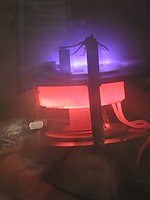
Photo from wikipedia
Epitaxial growth of ultrathin overlayers on solid substrate is critically dependent on the surface structure, and in this work near-surface doping is identified as another important growth factor. It is… Click to show full abstract
Epitaxial growth of ultrathin overlayers on solid substrate is critically dependent on the surface structure, and in this work near-surface doping is identified as another important growth factor. It is shown that growth of hexagonal boron nitride (h-BN) on Ni(111) through chemical vapor deposition or surface ammonization can be strongly modulated by near-surface B doping. Epitaxial h-BN islands form on clean Ni(111) surface, while both epitaxial and nonepitaxial h-BN islands grow on Ni(111) containing near-surface B atoms. Quantitative correlation of epitaxial growth and near-surface doping is unambiguously demonstrated. In situ spatially resolved surface science measurements based on photoemission electron microscopy and low energy electron microscopy in combination with density function calculations reveal that near-surface B atoms weaken the interaction between h-BN overlayer and Ni surface, which favor the nonepitaxial and metastable h-BN structures. The present work suggests that near-surface doping acts as an effective route to influence epitaxial growth of two-dimensional (2D) material overlayers on solids.
Journal Title: Advanced Materials Interfaces
Year Published: 2019
Link to full text (if available)
Share on Social Media: Sign Up to like & get
recommendations!